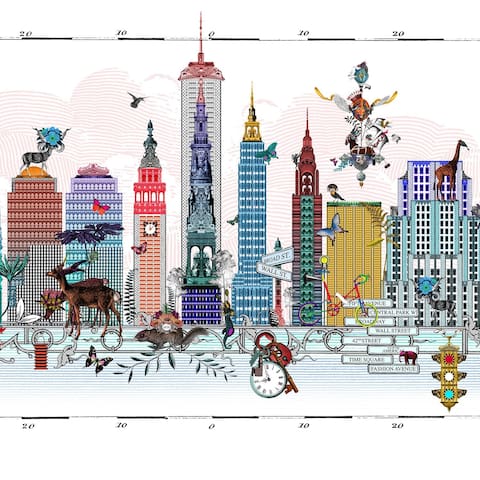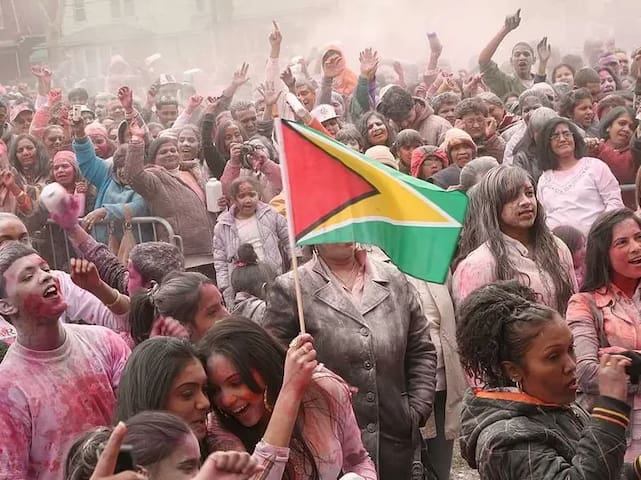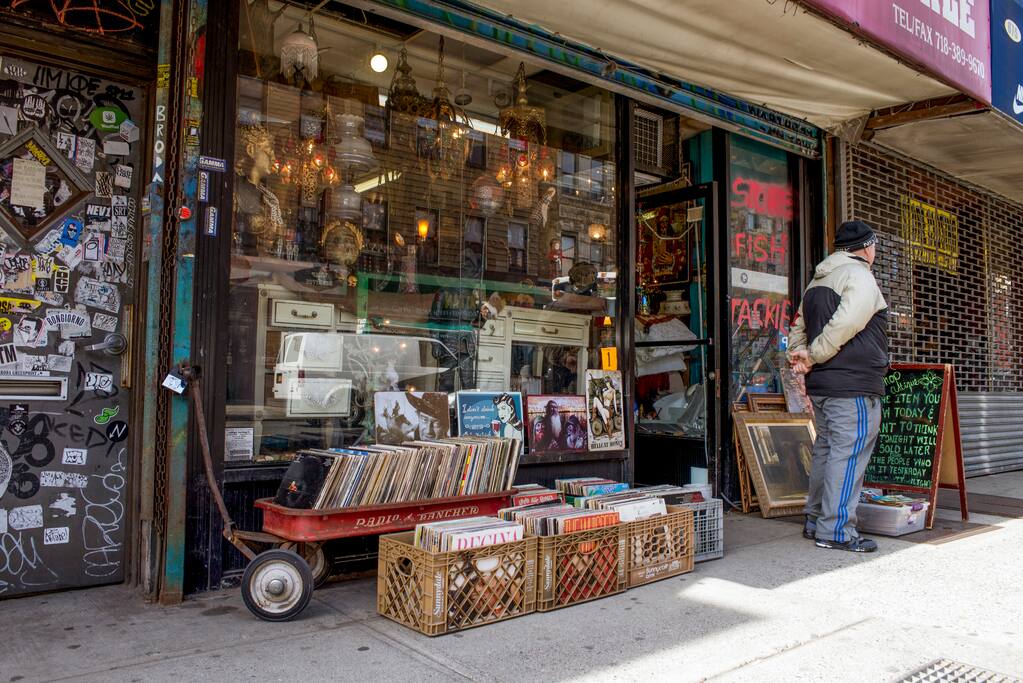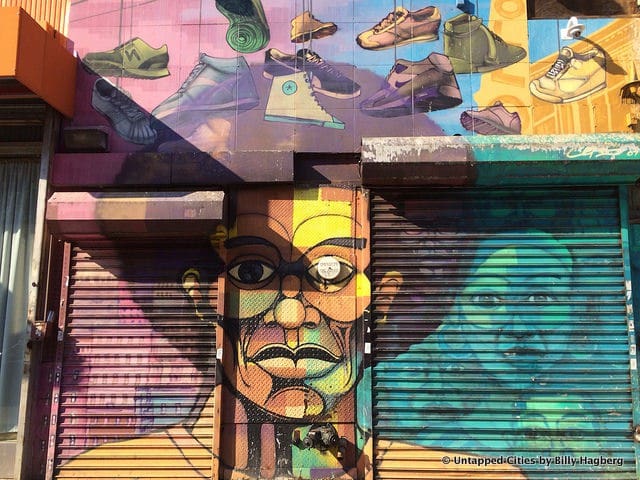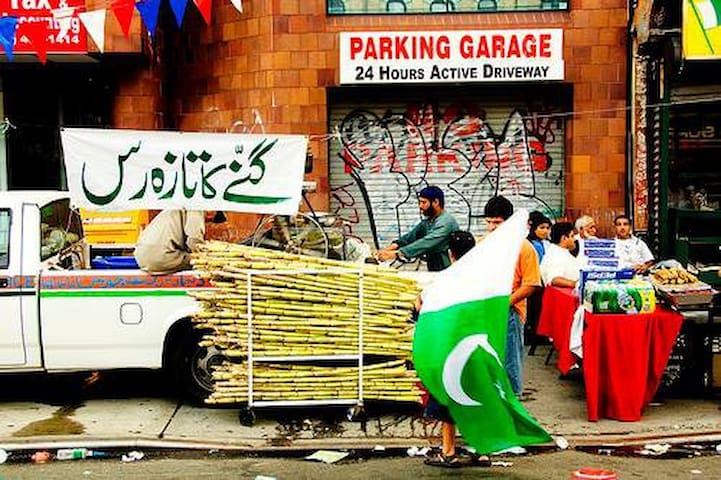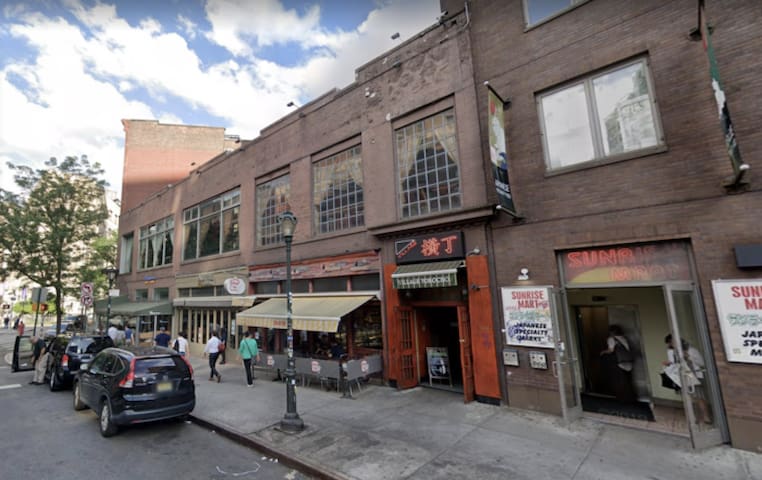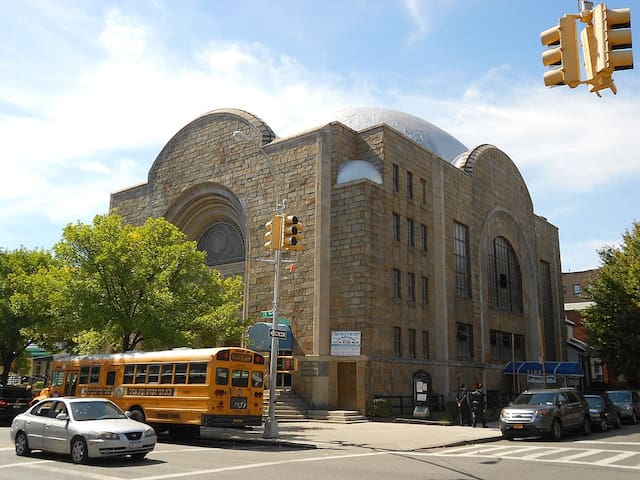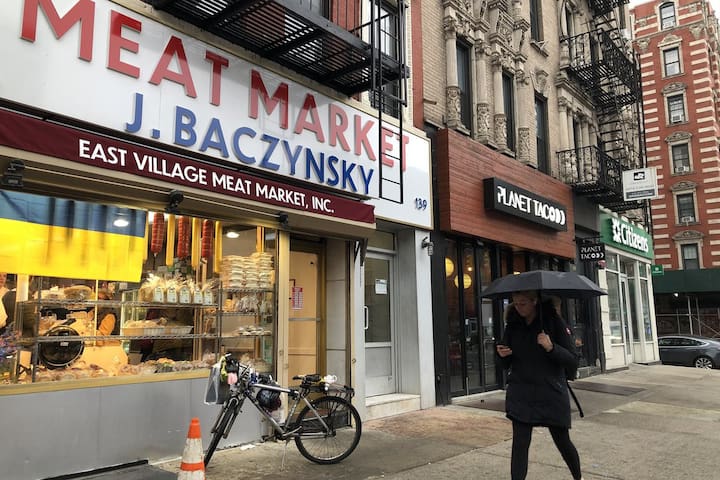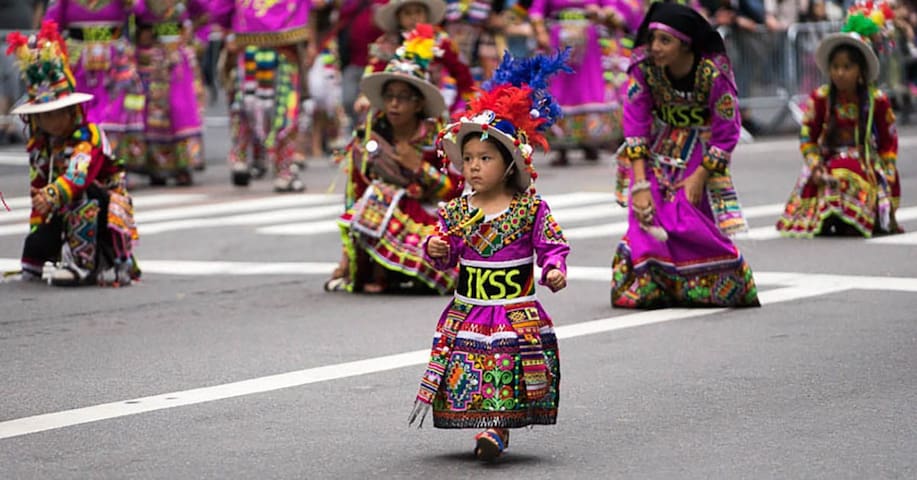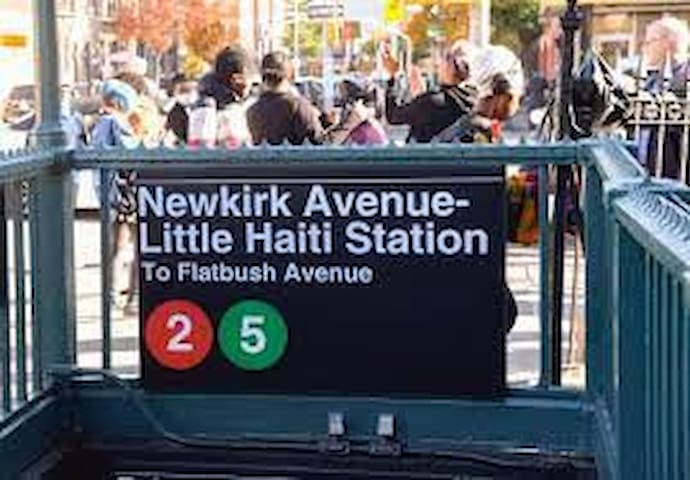City/town information
New York isn't known as a melting pot for nothing.
It's one of the most culturally diverse cities in the world, boasting dozens of under-the-radar ethnic enclaves that go far beyond a basic Chinatown. So here is a list of all NYC neighborhoods that will have you believing you've traveled the globe without even pulling out your passport.
74 locals recommend
New York
New York isn't known as a melting pot for nothing.
It's one of the most culturally diverse cities in the world, boasting dozens of under-the-radar ethnic enclaves that go far beyond a basic Chinatown. So here is a list of all NYC neighborhoods that will have you believing you've traveled the globe without even pulling out your passport.
Neighborhoods
You might not be able to place Guyana on a map, but it's taken over Richmond Hill. The small country on South America's Caribbean coast, east of Venezuela, has a population that's a colorful mix of South Asian (mostly from east India) and Afro-Caribbean.
New York is home to around 140,000 Guyanese, making them the fifth-largest group of immigrants in the city.
Liberty Avenue is Little Guyana's nucleus, featuring saris and spices, roti and rum, as well as businesses like the Little Guyana Bake Shop and The Hibiscus Restaurant & Bar.
Little Guyana
You might not be able to place Guyana on a map, but it's taken over Richmond Hill. The small country on South America's Caribbean coast, east of Venezuela, has a population that's a colorful mix of South Asian (mostly from east India) and Afro-Caribbean.
New York is home to around 140,000 Guyanese, making them the fifth-largest group of immigrants in the city.
Liberty Avenue is Little Guyana's nucleus, featuring saris and spices, roti and rum, as well as businesses like the Little Guyana Bake Shop and The Hibiscus Restaurant & Bar.
K-Town, a highly concentrated strip along Manhattan's West 32nd street, between Broadway and 5th Avenue, is a slice of Seoul in the city, and officially known as "Korea Way."
It features dozens of Korean restaurants, karaoke clubs, and even 24 hour spas, most of them stacked on top of each other thanks to the narrow borders of the area.
New York is home to over 140,000 Korean residents — the second largest Korean population in the US — and while they may not all live in Koreatown (many live in Flushing, Queens, another Korean hotspot), they do frequent it enthusiastically, giving the area a super local and authentic vibe.
While there's always a debate as to where the food is better, Flushing or Manhattan, K-Town is steadily gaining a stellar foodie rep.
159 locals recommend
Koreatown
K-Town, a highly concentrated strip along Manhattan's West 32nd street, between Broadway and 5th Avenue, is a slice of Seoul in the city, and officially known as "Korea Way."
It features dozens of Korean restaurants, karaoke clubs, and even 24 hour spas, most of them stacked on top of each other thanks to the narrow borders of the area.
New York is home to over 140,000 Korean residents — the second largest Korean population in the US — and while they may not all live in Koreatown (many live in Flushing, Queens, another Korean hotspot), they do frequent it enthusiastically, giving the area a super local and authentic vibe.
While there's always a debate as to where the food is better, Flushing or Manhattan, K-Town is steadily gaining a stellar foodie rep.
Little India, Jackson Heights, Queens
Jackson Heights is incredibly diverse, and it can make you feel like you've been transported to a different country with every block.
However, India (and Bangladesh and Pakistan) has staked its claim on 74th Street between Roosevelt and 37th Avenue, where women will shop for jewelry and rich fabrics while wearing colorful saris, and stores are full of Bollywood films and incense.
Like an open air market, the air is thick with the smell of curries and spices, and the streets are lined with sweet shops, curry houses, and eateries selling fresh curry leaves and chutneys.
60 locals recommend
Jackson Heights
Little India, Jackson Heights, Queens
Jackson Heights is incredibly diverse, and it can make you feel like you've been transported to a different country with every block.
However, India (and Bangladesh and Pakistan) has staked its claim on 74th Street between Roosevelt and 37th Avenue, where women will shop for jewelry and rich fabrics while wearing colorful saris, and stores are full of Bollywood films and incense.
Like an open air market, the air is thick with the smell of curries and spices, and the streets are lined with sweet shops, curry houses, and eateries selling fresh curry leaves and chutneys.
Little Odessa, Brighton Beach, Brooklyn
With a tight-knit Russian-speaking community dating back to the 1800s, Cyrillic signs and newspapers, Russian baths, Putin coffee mugs, and more fur coats than you can shake a stick at, you'll be forgiven for thinking you've landed in the Ukraine, despite the sandy beach (which is probably not much warmer than the Black Sea).
Brooklyn's southernmost spot, Little Odessa has one of the highest concentration of Russian immigrants this side of the globe, and New York as a whole is home to over 700,000 of them.
94 locals recommend
Brighton Beach
Little Odessa, Brighton Beach, Brooklyn
With a tight-knit Russian-speaking community dating back to the 1800s, Cyrillic signs and newspapers, Russian baths, Putin coffee mugs, and more fur coats than you can shake a stick at, you'll be forgiven for thinking you've landed in the Ukraine, despite the sandy beach (which is probably not much warmer than the Black Sea).
Brooklyn's southernmost spot, Little Odessa has one of the highest concentration of Russian immigrants this side of the globe, and New York as a whole is home to over 700,000 of them.
Sure, most US cities can boast Chinatowns, but New York's is one of the oldest in the country, as well as outside of Asia.
Once you bypass the fake purses, knockoff perfumes and general insanity of Canal Street, you'll enter a surreal, bustling world full of fruit and veggie stands overflowing with exotic produce you've never seen before, open air fish markets writhing with live eels, and parks full of people playing Xiàngqí (Chinese chess).
Dense and boisterous, Chinatown has 103,060 people per square mile to New York’s 27,183.
497 locals recommend
Chinatown
Sure, most US cities can boast Chinatowns, but New York's is one of the oldest in the country, as well as outside of Asia.
Once you bypass the fake purses, knockoff perfumes and general insanity of Canal Street, you'll enter a surreal, bustling world full of fruit and veggie stands overflowing with exotic produce you've never seen before, open air fish markets writhing with live eels, and parks full of people playing Xiàngqí (Chinese chess).
Dense and boisterous, Chinatown has 103,060 people per square mile to New York’s 27,183.
Little Australia, Nolita, Manhattan
Perhaps only Aussies call the area around Mulberry Street in downtown Manhattan "Little Australia" but hey, with more Australian-owned businesses than anywhere else in the city (around 10 on only six blocks) and flat whites and Vegemite aplenty, we dig the Down Under vibe of this little sub-hood.
71 locals recommend
Nolita
Little Australia, Nolita, Manhattan
Perhaps only Aussies call the area around Mulberry Street in downtown Manhattan "Little Australia" but hey, with more Australian-owned businesses than anywhere else in the city (around 10 on only six blocks) and flat whites and Vegemite aplenty, we dig the Down Under vibe of this little sub-hood.
Little Poland, Greenpoint, Brooklyn
Despite the onslaught of Williamsburg's infamous hipster set, Little Poland refuses to budge.
Though wildly international (read, gentrified), Polish is Greenpoint's foremost foreign population, with the second largest concentration of Poles after Chicago.
Polish culture here is tangible: you'll hear the language everywhere, and see it on every sign and marquee, and the Polish national symbol — a white eagle on a red background — is as ubiquitous as restaurants and shops selling pierogis and kielbasa.
119 locals recommend
Greenpoint
Little Poland, Greenpoint, Brooklyn
Despite the onslaught of Williamsburg's infamous hipster set, Little Poland refuses to budge.
Though wildly international (read, gentrified), Polish is Greenpoint's foremost foreign population, with the second largest concentration of Poles after Chicago.
Polish culture here is tangible: you'll hear the language everywhere, and see it on every sign and marquee, and the Polish national symbol — a white eagle on a red background — is as ubiquitous as restaurants and shops selling pierogis and kielbasa.
Back in the day, Little Italy was a Neapolitan village whose primary language was Italian.
Immigrants from Naples and Sicily flocked to it in the 1880s, and the area peaked in 1910, with a population of over 10,000 Italians and an area spanning 50 blocks. It has since shrunk (it's now around 14 blocks between Broome and Canal, Lafayette and Bowery), deteriorating into an enclave that can often feel like a souvenir slinging tourist trap.
However, it's a vibrant and fun neighborhood with narrow, European-feeling cobblestone streets full of gelaterias and bakeries, and real foodie gems, like Parm and Rubirosa. Don't miss September's Feast of San Gennaro, a colorful street festival and foodie fave.
312 locals recommend
Little Italy
189 Grand StBack in the day, Little Italy was a Neapolitan village whose primary language was Italian.
Immigrants from Naples and Sicily flocked to it in the 1880s, and the area peaked in 1910, with a population of over 10,000 Italians and an area spanning 50 blocks. It has since shrunk (it's now around 14 blocks between Broome and Canal, Lafayette and Bowery), deteriorating into an enclave that can often feel like a souvenir slinging tourist trap.
However, it's a vibrant and fun neighborhood with narrow, European-feeling cobblestone streets full of gelaterias and bakeries, and real foodie gems, like Parm and Rubirosa. Don't miss September's Feast of San Gennaro, a colorful street festival and foodie fave.
India Square, Jersey City, New Jersey
OK, this is technically in New Jersey but it is a short Path train away from New York City, so it belongs on the list.
Also known as Little India or Little Bombay, this area has the highest concentration of Asian Indians in the Western Hemisphere (more than 13k according to the last census, making almost 11% of Jersey City’s population).
Wandering down Newark Avenue you’ll come across sari shops, storefronts advertising Henna, Bollywood ads, dozens of Indian restaurants, and, once a year, the colorful Holi festival and Navratri celebrations.
68 locals recommend
Jersey City
India Square, Jersey City, New Jersey
OK, this is technically in New Jersey but it is a short Path train away from New York City, so it belongs on the list.
Also known as Little India or Little Bombay, this area has the highest concentration of Asian Indians in the Western Hemisphere (more than 13k according to the last census, making almost 11% of Jersey City’s population).
Wandering down Newark Avenue you’ll come across sari shops, storefronts advertising Henna, Bollywood ads, dozens of Indian restaurants, and, once a year, the colorful Holi festival and Navratri celebrations.
Little Dominican Republic in Washington Heights, Manhattan
Washington Heights shows its tradition proudly. Dominican Republic flags hang in apartment windows; Spanish is ubiquitous; and street stalls sell food and drink along major corridors up through neighboring Inwood. Spoken Spanish is only faded out by the ascending volume of Bachata, a Latin musical genre originating from the Dominican Republic. Here, you’ll observe families and friends congregating in the streets, dancing in the nearby parks. It is a neighborhood of families and neighbors whose culture resonates throughout.
Broadway serves as Washington Heights’ main commercial artery with a number of mom and pop specialty shops, Dominican cuisine locales, along with more recognized chain retailers. Among the numerous eateries, El Malecon proves to be a more popular presence in the neighborhood specializing in authentic Latin cooking. El Malecon features traditional Dominican dishes such as mangu or mashed green plantains, and sancocho, which is Dominican-style stew.
40 locals recommend
Washington Heights
Little Dominican Republic in Washington Heights, Manhattan
Washington Heights shows its tradition proudly. Dominican Republic flags hang in apartment windows; Spanish is ubiquitous; and street stalls sell food and drink along major corridors up through neighboring Inwood. Spoken Spanish is only faded out by the ascending volume of Bachata, a Latin musical genre originating from the Dominican Republic. Here, you’ll observe families and friends congregating in the streets, dancing in the nearby parks. It is a neighborhood of families and neighbors whose culture resonates throughout.
Broadway serves as Washington Heights’ main commercial artery with a number of mom and pop specialty shops, Dominican cuisine locales, along with more recognized chain retailers. Among the numerous eateries, El Malecon proves to be a more popular presence in the neighborhood specializing in authentic Latin cooking. El Malecon features traditional Dominican dishes such as mangu or mashed green plantains, and sancocho, which is Dominican-style stew.
Little Senegal in Harlem
Little Senegal, or “Le Petit Senegal” to many of the Francophone locals, is home to African immigrants from Senegal, the Ivory Coast, Ghana, Guinea, and more. It is centered around 116th Street and Lenox Avenue right in the middle of Harlem. Over the past 30 years, the population of immigrants from West African countries has slowly grown and expressed its influence in the area.
African restaurants like Le Baobab and African Kine have sprung around classics like Sylvia’s and Amy Ruth’s, while renowned Ethiopian born/Swedish raised chef Marcus Samuelson’s Red Rooster blends traditional soul and African food. And Lenox Sapphire, just across the street from Sylvia’s, is another Senegal-owned restaurant. There is also a permanent outdoor market in the area called “Malcolm Shabazz.” Businesses offer everything from traditional African clothing to cell phone plans with discount rates to Senegal or Ghana.
160 locals recommend
Harlem
Little Senegal in Harlem
Little Senegal, or “Le Petit Senegal” to many of the Francophone locals, is home to African immigrants from Senegal, the Ivory Coast, Ghana, Guinea, and more. It is centered around 116th Street and Lenox Avenue right in the middle of Harlem. Over the past 30 years, the population of immigrants from West African countries has slowly grown and expressed its influence in the area.
African restaurants like Le Baobab and African Kine have sprung around classics like Sylvia’s and Amy Ruth’s, while renowned Ethiopian born/Swedish raised chef Marcus Samuelson’s Red Rooster blends traditional soul and African food. And Lenox Sapphire, just across the street from Sylvia’s, is another Senegal-owned restaurant. There is also a permanent outdoor market in the area called “Malcolm Shabazz.” Businesses offer everything from traditional African clothing to cell phone plans with discount rates to Senegal or Ghana.
The Chinese, Taiwanese, Korean and Vietnamese Communities in Flushing, Queens
This neighborhood counts for 4 countries.
Though many know Lower Manhattan’s Chinatown for its dense Chinese population, Flushing, Queens has a nearly equal Chinese presence. About 70% of its population is Asian, making it a thriving ethnic micro neighborhood. In fact, according to a Daily News article citing the 2010 census, Flushing’s own Chinese population has overtaken that of Lower Manhattan’s Chinatown.
The heart of Flushing’s Asian community lies in Downtown Flushing, where the bustling streets and crowded markets are reflective of those in Asia. While the Chinese (and Taiwanese) presence is the most apparent, Flushing also has a large Korean community centered around Union Street and a smaller Vietnamese one.
A very popular destination in downtown Flushing is the New World Mall on the corner of Main Street and Roosevelt Avenue, which prides itself in being the largest indoor Asian mall on the East Coast. There are 108 retail shops and a huge Asian supermarket on the first and second floors. The third floor has one of the biggest Chinese dim sum restaurants and banquet halls in the Tri-State area. Its food court has a plethora of options for Asian cuisine, from shaved ice with varieties of toppings, bubble tea, soups and noodles. There is also a karaoke lounge. The Golden Mall is a more underground, though equally popular food destination where Xi-An Famous Foods had its start
89 locals recommend
Flushing
The Chinese, Taiwanese, Korean and Vietnamese Communities in Flushing, Queens
This neighborhood counts for 4 countries.
Though many know Lower Manhattan’s Chinatown for its dense Chinese population, Flushing, Queens has a nearly equal Chinese presence. About 70% of its population is Asian, making it a thriving ethnic micro neighborhood. In fact, according to a Daily News article citing the 2010 census, Flushing’s own Chinese population has overtaken that of Lower Manhattan’s Chinatown.
The heart of Flushing’s Asian community lies in Downtown Flushing, where the bustling streets and crowded markets are reflective of those in Asia. While the Chinese (and Taiwanese) presence is the most apparent, Flushing also has a large Korean community centered around Union Street and a smaller Vietnamese one.
A very popular destination in downtown Flushing is the New World Mall on the corner of Main Street and Roosevelt Avenue, which prides itself in being the largest indoor Asian mall on the East Coast. There are 108 retail shops and a huge Asian supermarket on the first and second floors. The third floor has one of the biggest Chinese dim sum restaurants and banquet halls in the Tri-State area. Its food court has a plethora of options for Asian cuisine, from shaved ice with varieties of toppings, bubble tea, soups and noodles. There is also a karaoke lounge. The Golden Mall is a more underground, though equally popular food destination where Xi-An Famous Foods had its start
Little Ireland in Woodlawn, The Bronx
In the northern Bronx, just above its namesake cemetery and east of Van Cortlandt Park, you can find New York City’s own Little Ireland. The neighborhood of Woodlawn Heights or simply Woodlawn, as it is better known, has been a destination for the Irish exodus in New York City. Though originally populated by Germans, Woodlawn is now predominantly Irish with its share of Italian-Americans as well. It is here that you’ll find the greatest abundance of four-leaf clover insignias on storefronts in all of the city.
Although Woodlawn has its definitive borders, the Irish community itself is present on both sides of McLean Avenue, which serves as the border between New York City and Yonkers. The majority of residents have lived here for generations, making it home to both an Irish-American and Irish immigrant population. The neighborhood’s proximity to Manhattan, along with the variety of imported Irish products available have long been attracting its inhabitants from across the ocean.
The commotion can be felt on Katonah Avenue, the main commercial district dotted with Irish pubs, cafés, restaurants and even shops specializing in authentic Irish imported goods and gifts. If it’s Irish style partying that you’re craving, be sure to stop at the Rambling House or The Tombstone Saloon. When hunger strikes, Mary’s Celtic Kitchen and Patrizia’s Of Woodlawn will satiate any palate. There’s also the Woodlawn Arts and Music House sure to satisfy local artists.
Woodlawn Heights
Little Ireland in Woodlawn, The Bronx
In the northern Bronx, just above its namesake cemetery and east of Van Cortlandt Park, you can find New York City’s own Little Ireland. The neighborhood of Woodlawn Heights or simply Woodlawn, as it is better known, has been a destination for the Irish exodus in New York City. Though originally populated by Germans, Woodlawn is now predominantly Irish with its share of Italian-Americans as well. It is here that you’ll find the greatest abundance of four-leaf clover insignias on storefronts in all of the city.
Although Woodlawn has its definitive borders, the Irish community itself is present on both sides of McLean Avenue, which serves as the border between New York City and Yonkers. The majority of residents have lived here for generations, making it home to both an Irish-American and Irish immigrant population. The neighborhood’s proximity to Manhattan, along with the variety of imported Irish products available have long been attracting its inhabitants from across the ocean.
The commotion can be felt on Katonah Avenue, the main commercial district dotted with Irish pubs, cafés, restaurants and even shops specializing in authentic Irish imported goods and gifts. If it’s Irish style partying that you’re craving, be sure to stop at the Rambling House or The Tombstone Saloon. When hunger strikes, Mary’s Celtic Kitchen and Patrizia’s Of Woodlawn will satiate any palate. There’s also the Woodlawn Arts and Music House sure to satisfy local artists.
Little Greece, Astoria Queens
Occupying a rectangular region bounded by Ditmars Boulevard, Steinway Street, 36th Avenue and the East River is a neighborhood filled with traditional Greek taverns, bakeries, cafes and orthodox churches. Over the years, the Greek presence has shifted from Ditmars Boulevard to Broadway.
Large groups of Greeks migrated to the the region in the 1960s, with more immigrants arriving from Cyprus in 1974. In 1980, the population of Greeks in Astoria was 22,579, though that number dropped to 18,127 in 1990. Recently, the Queens Chronicle reported that the current Greek debt crisis has led to another influx of Greek immigrants to Astoria. Popular traditional Greek eateries in this neighborhood include Taverna Kyclades, Bahari Estiatorio, and the Omonia Cafe.
125 locals recommend
Astoria
Little Greece, Astoria Queens
Occupying a rectangular region bounded by Ditmars Boulevard, Steinway Street, 36th Avenue and the East River is a neighborhood filled with traditional Greek taverns, bakeries, cafes and orthodox churches. Over the years, the Greek presence has shifted from Ditmars Boulevard to Broadway.
Large groups of Greeks migrated to the the region in the 1960s, with more immigrants arriving from Cyprus in 1974. In 1980, the population of Greeks in Astoria was 22,579, though that number dropped to 18,127 in 1990. Recently, the Queens Chronicle reported that the current Greek debt crisis has led to another influx of Greek immigrants to Astoria. Popular traditional Greek eateries in this neighborhood include Taverna Kyclades, Bahari Estiatorio, and the Omonia Cafe.
Little Colombia in Jackson Heights, Queens
Though Jackson Heights is primarily known as an Indian neighborhood, it is also home to a concentrated Colombian population and several Colombian businesses. Roughly running between 80th to 84th streets and between Roosevelt Avenue and 37th avenue, Little Colombia is a center of Colombian life in Queens, which has the largest Colombian population in the United States.
60 locals recommend
Jackson Heights
Little Colombia in Jackson Heights, Queens
Though Jackson Heights is primarily known as an Indian neighborhood, it is also home to a concentrated Colombian population and several Colombian businesses. Roughly running between 80th to 84th streets and between Roosevelt Avenue and 37th avenue, Little Colombia is a center of Colombian life in Queens, which has the largest Colombian population in the United States.
Little Puerto Rico in Clason Point, The Bronx
Nestled on a peninsula in the South Bronx near Harding Park is Little Puerto Rico, which is about 80% Latino and Hispanic, with Puerto Ricans constituting the largest ethnic group. Its narrow streets and small former bungalow houses (there is often very little space between homes located across from each other), this neighborhood is strikingly different from others in the city. There are chickens roaming around the houses, some of which have small vegetable gardens and colorful decor. There are also nearby fishing locations and vacant “desert-like” areas.
Many Puerto Ricans moved here in the 1960s, and by the 1990s, people were calling it “Little Puerto Rico.” The area used to be mainly Irish, Italian and Jewish; however these immigrants could not own this property. Then, a pioneering group of Puerto Ricans and other Latino groups arrived and bought most of the 250 bungalow homes, renovating them and gradually making the area a close-knit community
Clason Point
Little Puerto Rico in Clason Point, The Bronx
Nestled on a peninsula in the South Bronx near Harding Park is Little Puerto Rico, which is about 80% Latino and Hispanic, with Puerto Ricans constituting the largest ethnic group. Its narrow streets and small former bungalow houses (there is often very little space between homes located across from each other), this neighborhood is strikingly different from others in the city. There are chickens roaming around the houses, some of which have small vegetable gardens and colorful decor. There are also nearby fishing locations and vacant “desert-like” areas.
Many Puerto Ricans moved here in the 1960s, and by the 1990s, people were calling it “Little Puerto Rico.” The area used to be mainly Irish, Italian and Jewish; however these immigrants could not own this property. Then, a pioneering group of Puerto Ricans and other Latino groups arrived and bought most of the 250 bungalow homes, renovating them and gradually making the area a close-knit community
Little Pakistan, Coney Island Avenue Brooklyn
Though it may seem surprising, the largest Pakistani population in New York City is located on Coney Island Avenue. Beforehand, this area was primarily Jewish (and there is still a large Jewish population in the area) until Pakistani migration in the 1990s. The number of Pakistanis in Brooklyn was roughly 9,903 in 2010. However, Little Pakistan was almost nonexistent after 9/11.
After 9/11, several agencies came into Middle Eastern and South Asian neighborhoods looking for suspicious activities and inciting fear in residents, some of whom could face deportation for small immigration-related problems. As a result of this suspicion and interrogation, business in Little Pakistan dropped by 50%. At the peak of this time, 20,000 members of Brooklyn’s Pakistani population left the United States.
Since then, however, the area has recovered and is now filled with Pakistani restaurants (four of which are open 24-hours), salons and jewelry shops.
12 locals recommend
Coney Island Avenue
Coney Island AvenueLittle Pakistan, Coney Island Avenue Brooklyn
Though it may seem surprising, the largest Pakistani population in New York City is located on Coney Island Avenue. Beforehand, this area was primarily Jewish (and there is still a large Jewish population in the area) until Pakistani migration in the 1990s. The number of Pakistanis in Brooklyn was roughly 9,903 in 2010. However, Little Pakistan was almost nonexistent after 9/11.
After 9/11, several agencies came into Middle Eastern and South Asian neighborhoods looking for suspicious activities and inciting fear in residents, some of whom could face deportation for small immigration-related problems. As a result of this suspicion and interrogation, business in Little Pakistan dropped by 50%. At the peak of this time, 20,000 members of Brooklyn’s Pakistani population left the United States.
Since then, however, the area has recovered and is now filled with Pakistani restaurants (four of which are open 24-hours), salons and jewelry shops.
Little West Indies in Crown Heights, Brooklyn
Though the micro neighborhood seems to get smaller and smaller, a strong West Indian and Caribbean presence is still present around Nostrand Avenue between Eastern Parkway and Fulton Street. The most famous food joint may be Gloria’s, seen on Anthony Bourdain’s No Reservations, but there are plenty of other spots to check out as well, including The Food Sermon (which is south of Eastern Parkway), Peppa Jerk Chicken, and more. The West Indian Parade is a festive.
71 locals recommend
Crown Heights
Little West Indies in Crown Heights, Brooklyn
Though the micro neighborhood seems to get smaller and smaller, a strong West Indian and Caribbean presence is still present around Nostrand Avenue between Eastern Parkway and Fulton Street. The most famous food joint may be Gloria’s, seen on Anthony Bourdain’s No Reservations, but there are plenty of other spots to check out as well, including The Food Sermon (which is south of Eastern Parkway), Peppa Jerk Chicken, and more. The West Indian Parade is a festive.
Little Sri Lanka in Tompkinsville, Staten Island
Home to about 5,000 Sri Lankans and restaurants serving traditional roti, dosas, and Sri Lankan crepes and stews, Little Sri Lanka is a little-known cultural gem that is also the most popular homes for Sri Lankans other than Sri Lanka itself.
Attracted by Staten Island’s affordable property and proximity to Manhattan, the Sri Lankan population in the neighborhood has increased rapidly in recent years while keeping connections to their home country. In 2012 they celebrated New Year in Ocean Breeze with traditional Sri Lankan festivities and in 2014 they collaborated to send aid to Sri Lanka in wake of a tsunami.
Tompkinsville
Little Sri Lanka in Tompkinsville, Staten Island
Home to about 5,000 Sri Lankans and restaurants serving traditional roti, dosas, and Sri Lankan crepes and stews, Little Sri Lanka is a little-known cultural gem that is also the most popular homes for Sri Lankans other than Sri Lanka itself.
Attracted by Staten Island’s affordable property and proximity to Manhattan, the Sri Lankan population in the neighborhood has increased rapidly in recent years while keeping connections to their home country. In 2012 they celebrated New Year in Ocean Breeze with traditional Sri Lankan festivities and in 2014 they collaborated to send aid to Sri Lanka in wake of a tsunami.
Little Tibet in Jackson Heights, Queens
At certain times of the year, you can see native Tibetans dressed in fancy, traditional attire in the area around 74th street between Roosevelt and 37th Avenues in Jackson Heights on certain religious holidays. The area also has at least a dozen Tibetan and Nepalese restaurants in the area and “Tibetan Mobile,” a cell phone store. A 2011 New York Magazine article gave two nicknames to this area: Little Tibet and Himalayan Heights. While this area has been a recent development, it is thriving for now.
60 locals recommend
Jackson Heights
Little Tibet in Jackson Heights, Queens
At certain times of the year, you can see native Tibetans dressed in fancy, traditional attire in the area around 74th street between Roosevelt and 37th Avenues in Jackson Heights on certain religious holidays. The area also has at least a dozen Tibetan and Nepalese restaurants in the area and “Tibetan Mobile,” a cell phone store. A 2011 New York Magazine article gave two nicknames to this area: Little Tibet and Himalayan Heights. While this area has been a recent development, it is thriving for now.
Little Manila in Woodside, Queens
Home to countless authentic Filipino restaurants and businesses, “Little Manila,” which runs from 63rd to 71st Street in Woodside, Queens makes Filipino immigrants feel at home.
New York State’s Filipino population is about 200,000 and the majority of these Filipinos live in the Little Manila area. One orienting point in this neighborhood is the bee greeting customers outside the Filipino fast food chain, Jollibee. Though there are over 500 of these chains worldwide, Little Manila’s Jollibee, established in 2009 something, was the first on the East Coast. Red Ribbon, a Filipino chain bakery, also found its place here in 2010.
Other restaurants include Ihawan (famous for their traditional barbeque), Perlas ng Silangan, Renee’s Kitchenette, Fritzie’s Bakeshop and Krystal’s Cafe, all of which sell traditional Filipino dishes. There is also a Philippine National Bank, a Filipino recreational center and Filipino salons and grocery stores.
9 locals recommend
Woodside
Little Manila in Woodside, Queens
Home to countless authentic Filipino restaurants and businesses, “Little Manila,” which runs from 63rd to 71st Street in Woodside, Queens makes Filipino immigrants feel at home.
New York State’s Filipino population is about 200,000 and the majority of these Filipinos live in the Little Manila area. One orienting point in this neighborhood is the bee greeting customers outside the Filipino fast food chain, Jollibee. Though there are over 500 of these chains worldwide, Little Manila’s Jollibee, established in 2009 something, was the first on the East Coast. Red Ribbon, a Filipino chain bakery, also found its place here in 2010.
Other restaurants include Ihawan (famous for their traditional barbeque), Perlas ng Silangan, Renee’s Kitchenette, Fritzie’s Bakeshop and Krystal’s Cafe, all of which sell traditional Filipino dishes. There is also a Philippine National Bank, a Filipino recreational center and Filipino salons and grocery stores.
Little Egypt, Astoria Queens
There are approximately 10 million Egyptians living abroad, about 15 percent in the United States alone. It’s no secret that Egyptians make a home for themselves wherever they go, and it’s easy to spot an Egyptian wherever you are in the world. Particularly in New York City, there are several hotspots for the Egyptian community and the Arab community as a whole.
“Little Egypt” features not only authentic Egyptian restaurants but also a Jewish Egyptian congregation.
125 locals recommend
Astoria
Little Egypt, Astoria Queens
There are approximately 10 million Egyptians living abroad, about 15 percent in the United States alone. It’s no secret that Egyptians make a home for themselves wherever they go, and it’s easy to spot an Egyptian wherever you are in the world. Particularly in New York City, there are several hotspots for the Egyptian community and the Arab community as a whole.
“Little Egypt” features not only authentic Egyptian restaurants but also a Jewish Egyptian congregation.
Little Britain, Manhattan
The streets around Greenwich Avenue in Manhattan would appear to have little in common with village greens and warm beer. However, because of the sheer number of British businesses in the district, Anglophiles in New York are campaigning to have a corner of the island officially renamed Little Britain.
Try English-themed cafe Tea & Sympathy, while next door is the fish and chip shop A Salt and Battery, and on the other side is a children's clothes store Showroom 64. Nearby Hudson Street is home to British grocery emporium Myers of Keswick, while designers Stella McCartney, Lulu Guinness and Mulberry all have outlets in the area.
Greenwich Street
Greenwich StreetLittle Britain, Manhattan
The streets around Greenwich Avenue in Manhattan would appear to have little in common with village greens and warm beer. However, because of the sheer number of British businesses in the district, Anglophiles in New York are campaigning to have a corner of the island officially renamed Little Britain.
Try English-themed cafe Tea & Sympathy, while next door is the fish and chip shop A Salt and Battery, and on the other side is a children's clothes store Showroom 64. Nearby Hudson Street is home to British grocery emporium Myers of Keswick, while designers Stella McCartney, Lulu Guinness and Mulberry all have outlets in the area.
Little Italy, Belmont, Bronx
Some would say that this is the real "little Italy" as the one in Manhattan today has been over-run by tourist traps and sub-par restaurants. But whatever your beliefs, it's hard to deny that the Bronx Little Italy does cater more to real Italian-Americans.
The authentic Italian culture found in the vibrant community of Bronx Little Italy sustains a thriving business district that includes world-class restaurants, high-quality artisanal food shops, and specialty stores carrying handmade local and imported items that you’d be hard-pressed to find elsewhere. Charming old-world ambiance emanates from the generations of Italian families who continue to give the area a welcoming small-town character that is unique for an urban setting.
Belmont
Little Italy, Belmont, Bronx
Some would say that this is the real "little Italy" as the one in Manhattan today has been over-run by tourist traps and sub-par restaurants. But whatever your beliefs, it's hard to deny that the Bronx Little Italy does cater more to real Italian-Americans.
The authentic Italian culture found in the vibrant community of Bronx Little Italy sustains a thriving business district that includes world-class restaurants, high-quality artisanal food shops, and specialty stores carrying handmade local and imported items that you’d be hard-pressed to find elsewhere. Charming old-world ambiance emanates from the generations of Italian families who continue to give the area a welcoming small-town character that is unique for an urban setting.
Little Tokyo, Noho - Bowery, Manhattan
You’ll find Little Tokyo in NYC, located on the corner of Stuyvesant and East 9th. It neighbours Noho and Bowery, on the south east of Manhattan, and it’s only a short walk from Union Square.
From sushi and noodles to old-fashioned tea houses, Little Tokyo in NYC is genuinely one of the quaintest areas in NYC. Not such a foodie? That’s all good, as Little Tokyo is packed to the brim with fashion stores, toy stores, and awesome salons that are sure to keep you coming back for the Harajuku experience!
19 locals recommend
NoHo
Little Tokyo, Noho - Bowery, Manhattan
You’ll find Little Tokyo in NYC, located on the corner of Stuyvesant and East 9th. It neighbours Noho and Bowery, on the south east of Manhattan, and it’s only a short walk from Union Square.
From sushi and noodles to old-fashioned tea houses, Little Tokyo in NYC is genuinely one of the quaintest areas in NYC. Not such a foodie? That’s all good, as Little Tokyo is packed to the brim with fashion stores, toy stores, and awesome salons that are sure to keep you coming back for the Harajuku experience!
Little Israel, Borough Park, Brooklyn
Jewish immigrants began populating Borough Park at the turn of the 20th century, beginning in 1904–1905.[16] By 1914, a YMHA had formed and purchased a lot on 58th Street and 14th Avenue on which to build a large facility.[17] Through the 1930s, 13th Avenue was lined with pushcart vendors[18] and pickle sellers.[19] In the late 1930s, the city opened a public market on 42nd Street to force an end to the pushcart trade.
In the 1980s, the neighborhood changed demographically — from one of Italian, Irish, and Modern Orthodox Jewish to Hasidic Jewish families. By 1983, an estimated 85 percent of the residents of Borough Park were Jewish.
6 locals recommend
Borough Park
Little Israel, Borough Park, Brooklyn
Jewish immigrants began populating Borough Park at the turn of the 20th century, beginning in 1904–1905.[16] By 1914, a YMHA had formed and purchased a lot on 58th Street and 14th Avenue on which to build a large facility.[17] Through the 1930s, 13th Avenue was lined with pushcart vendors[18] and pickle sellers.[19] In the late 1930s, the city opened a public market on 42nd Street to force an end to the pushcart trade.
In the 1980s, the neighborhood changed demographically — from one of Italian, Irish, and Modern Orthodox Jewish to Hasidic Jewish families. By 1983, an estimated 85 percent of the residents of Borough Park were Jewish.
Little Ukraine, East Village, Manhattan
The area of the East Village centered on 6th and 7th street between 1st and 3rd Avenues used to be known as “Little Ukraine.” Even though the neighborhood is now diverse and has mostly lost its nickname, there are still some hidden gems left over from when the area was a Ukrainian mecca. The best days to embark on your mini tour of Ukraine would be Wednesday through Sunday, because that is when the Ukrainian Museum is open. Even though it is not Ukrainian, we recommend grabbing an ice cream at The Big Gay Ice Cream Shop after your meal at Veselka, while you are in the area.
216 locals recommend
East Village
Little Ukraine, East Village, Manhattan
The area of the East Village centered on 6th and 7th street between 1st and 3rd Avenues used to be known as “Little Ukraine.” Even though the neighborhood is now diverse and has mostly lost its nickname, there are still some hidden gems left over from when the area was a Ukrainian mecca. The best days to embark on your mini tour of Ukraine would be Wednesday through Sunday, because that is when the Ukrainian Museum is open. Even though it is not Ukrainian, we recommend grabbing an ice cream at The Big Gay Ice Cream Shop after your meal at Veselka, while you are in the area.
Little Ecuador, Corona, Queens
Today, New York City has one of the highest percentages of Ecuadorian-Americans, and Corona, Queens and Jackson Heights, Queens is where many of them reside. According to statista.com, Queens County had the largest Ecuadorian-American population group in the U.S., with a total of 98,512 “people of Ecuadorian origin.”
7 locals recommend
Corona
Little Ecuador, Corona, Queens
Today, New York City has one of the highest percentages of Ecuadorian-Americans, and Corona, Queens and Jackson Heights, Queens is where many of them reside. According to statista.com, Queens County had the largest Ecuadorian-American population group in the U.S., with a total of 98,512 “people of Ecuadorian origin.”
Little Haiti, Flatbush, Brooklyn
“Little Haiti” is defined as the area roughly within East 16th Street, Parkside Avenue, Brooklyn Avenue, and along Church Avenue between East 16th Street and Albany Avenue.
Newkirk Avenue
Newkirk AvenueLittle Haiti, Flatbush, Brooklyn
“Little Haiti” is defined as the area roughly within East 16th Street, Parkside Avenue, Brooklyn Avenue, and along Church Avenue between East 16th Street and Albany Avenue.

